It’s not at all hard to sell Orange Beach as the ultimate fishing destination. It’s long been known as the “Red Snapper Capital of the World,” a title it earns fair and square, which automatically translates into amazing angling. Plus, there are various Billfishing tournaments in the area every year, which also tells a lot. While nearshore and offshore action gets its glory, the inshore fishing Orange Beach has to offer shouldn’t be overlooked.
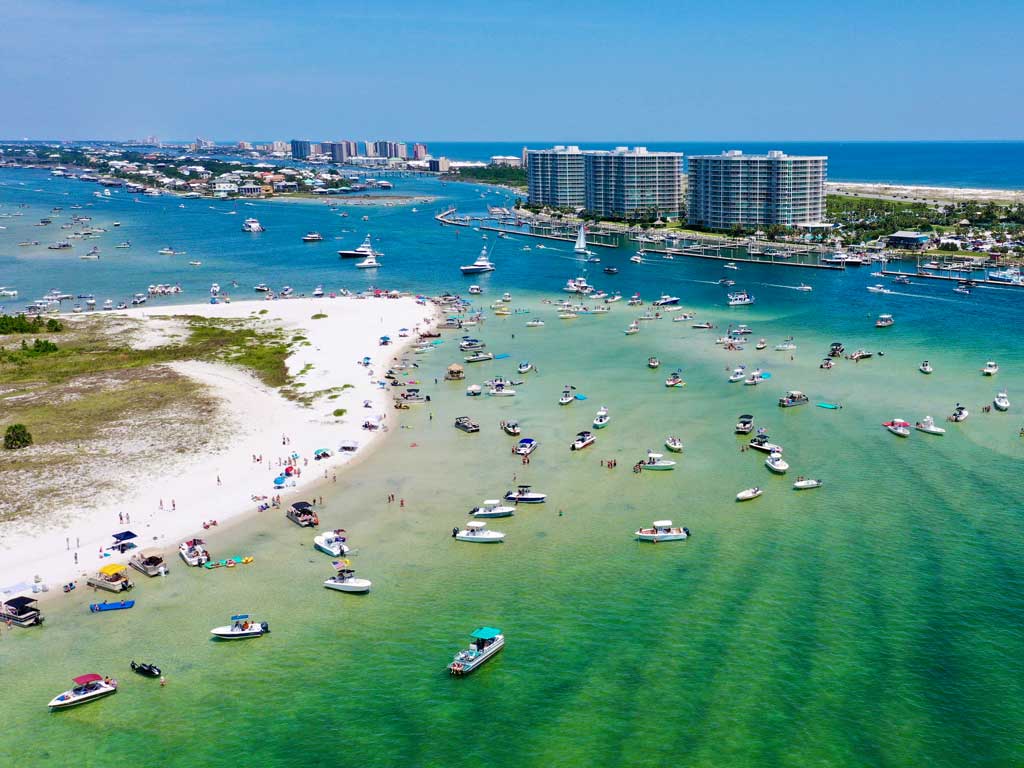
Why? Well, for a variety of reasons. Whenever you come to town, there’ll be something biting. And the fishing menu is pretty impressive, too. In this guide, we’ll break down what makes the Orange Beach inshore fishing scene so special and how you can get the most out of it.
Why Orange Beach?
So, what exactly makes Orange Beach inshore fishing so great? First of all, there’s the mighty Gulf of Mexico to the south and Cotton Bayou to the north. Perdido Pass, Gulf Shores, Mobile Bay, and the Flora-Bama line are all just a couple of miles away.
Wherever you turn, there are productive playgrounds for the all-star cast. These mostly calm, protected waters teem with various prized inshore fish species. Some of them call these waters home, while others just pass through Orange Beach.
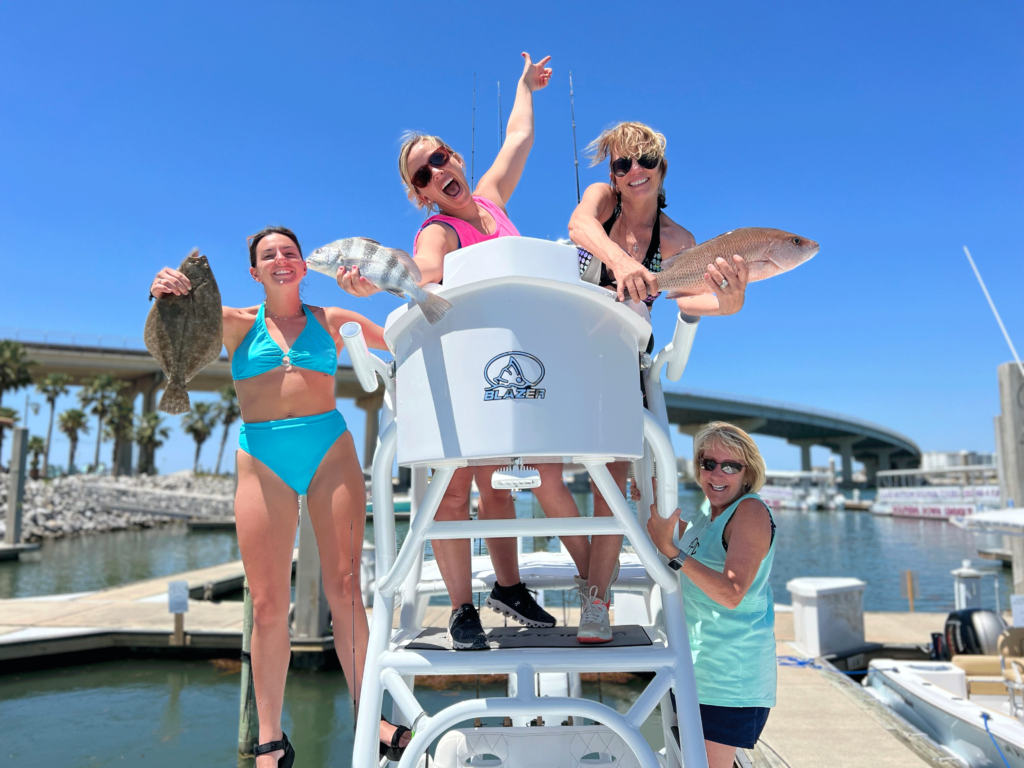
As we mentioned above, the list of potential inshore catches stays impressive throughout the seasons. Each month brings something exciting for the inshore enthusiasts – you just need to have a local guide by your side. Booking a trip with a knowledgeable captain increases your chances of landing a nice catch, practicing your angling skills, and just generally having a good time with your friends or family.
What can I catch inshore fishing in Orange Beach?

There are so many fish to choose from that both visitors and resident anglers are practically spoiled with choice. In fact, if we were to discuss every potential target in detail, we’d need a separate article for Redfish and Speckled Trout alone. And this is without the migrating Pompano and Tarpon!
In this section, we’ll talk about our favorites from the Orange Beach inshore fishing scene. If you’re looking to learn more about the state’s bag and size limits, feel free to consult the DCNR website.
Let’s start with the number one catch here, Redfish.
Redfish
There are two types of Redfish in Orange Beach. This is a major spawning zone for “Bull” Redfish from October into early December. During this period, anglers can come across large schools of Reds passing along the beaches and into the bays and passes.
Typical Bull Redfish are well above the 16–26 inch slot limit for Alabama, though. When targeting such a trophy, it’s essential to practice catch and release. It’s an excellent opportunity to test your angling skills, take a couple of pictures with your trophy catch, and release them back into the water safe and unharmed.

The second type of Redfish is keeper-size fish, which provide the best meat. These can be caught any time of year. Just like Bulls, these Reds are also pretty energetic and put up a nice fight. The state’s daily bag limit of Redfish is usually three fish within the 16–26 inch slot limit.
Finding Redfish in Orange Beach isn’t that hard. Look for areas with docks that provide shade and structure. Head to sandy cuts, oyster banks, and flats’ edges. The Little Lagoon and Perdido Bay are usual go-to places for both trophy Bull and smaller keepers throughout the year.
Speckled Trout
Just like Redfish, Speckled Trout are among the highest-paid cast on the Orange Beach inshore fishing stage. The area has plenty of “Gator” Trout, along with keeper-size Specks that are as exciting to catch.
Trout fishing in Orange Beach is also a year-round pleasure. From April through October, anglers can look for Speckled Trout around docks and marsh edges. During the fall months, schools of Trout hang out in the open bays, especially in Mobile Bay. Come winter, a lot of local anglers switch to fishing flats near deeper bays and channels where Specks retreat after a cold front.

Unlike Reds, Orange Beach Trout prefer clear-water areas with higher salinity and water temperatures from the low 60s to 80s. Flats and fairly shallow water are the best spots to find Speckled Trout. They might move to deeper areas during heavy rains, but will follow the bait into creeks and bayous if there’s a longer period of drought.
Since inshore anglers have been particularly active in the past decade or so, the Alabama Marine Resources Division introduced bag and size limits for Speckled Trout. Anglers can keep six fish per person with a slot limit of 15–22 inches. If you catch a Trout larger than 22 inches, you may keep just one fish.
Flounder
There are two types of Flounder on the Alabama coast – Southern Flounder and Gulf Flounder. The latter is normally smaller, but you might have higher chances of coming across one. Just head to spots such as the jetties and rockpiles at Perdido Pass.
These flatfish often hang out in groups, looking to score an easy meal around channel edges and dropoffs. If you’re after both types of Flounder, the piers around Ono Island and back bays along the island beaches are your best bet. Perdido Bay, Fort Morgan, Little Lagoon, and Mobile Bay are excellent spots to look for Flounder.
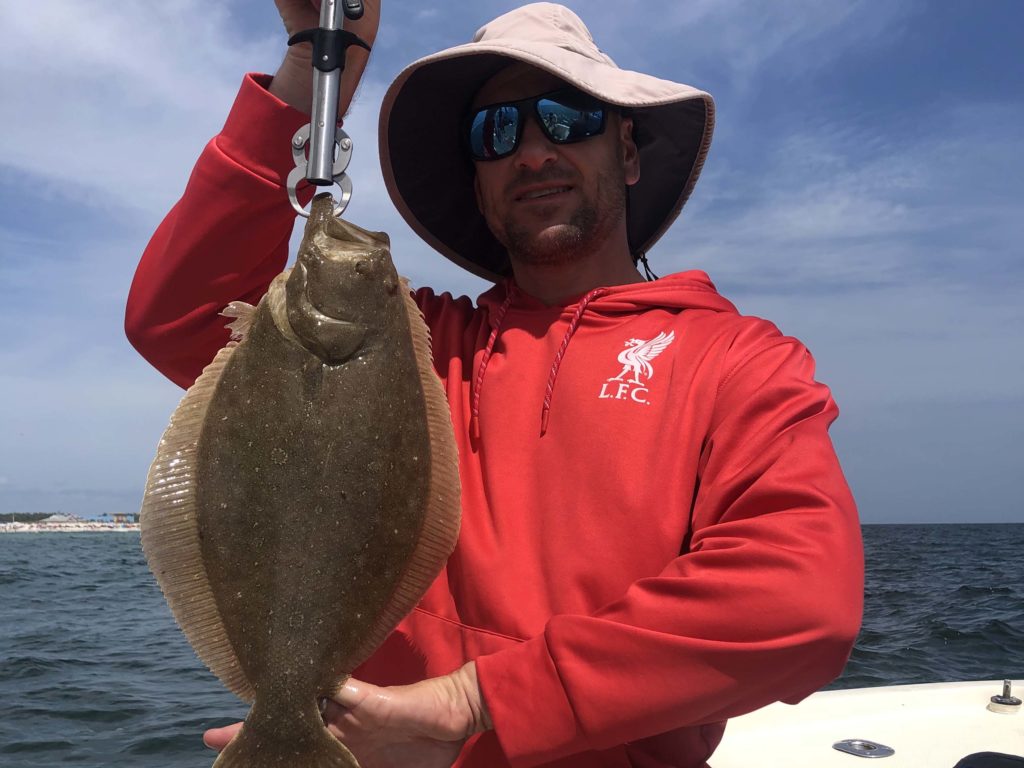
So, when’s the best time to fish for Flounder in Orange Beach? The short answer is any time of the year is a good time. There are several factors that may affect the success of your Flounder trips, such as tide patterns and moon phases.
Generally, spring and fall provide good action around the Perdido Pass area, especially from May to June and October to November. The annual Flounder run happens in November when the fish flow through the passes out of the bays to spawn on the reefs.
The technique you choose might also affect the bite. Some anglers stick to the good old live bait, light tackle, and light-line fishing methods, while others prefer to harvest their “Doormat” by gigging.
Keep in mind that there’s a size limit for Flounder, which is 14 inches in total length. The daily bag limit is five Flounder per person.
Tripletail
Tripletail are another favorite species among Orange Beach inshore anglers. Some local guides even call Tripletail the coolest inshore species on the Alabama Gulf Coast!
Tripletail aren’t the easiest target, though. As soon as the fish take your bait, you have around 10 seconds to make sure you don’t lose it. Tripletail are extraordinarily strong and can easily peel off your line. When targeting Tripletail, your guide might use a heavier line that helps to cut down on break-offs, especially when you pull across structure.
Areas around structure are actually the best spots to target Tripletail. They regularly move from one structure to another, so you might want to look for crab traps and channel markers to locate your target.

The summer months are the best time to fish for Tripletail in Orange Beach. However, if you’re lucky, you can spot them any time of the year. December anglers have the lowest chances to land Tripletail, as well as those who fish from January through March.
The daily bag limit is three fish with an 18-inch length limit. If you’re worried about the limit, ask any local guide, and they’ll tell you that you’ll be happy if you put at least one Tripletail in your ice chest!
Pompano
If you thought Tripletail were the hardest-fighting fish in Orange Beach, you’re not ready to hear about Pompano. These beautiful monsters travel in schools, arriving on the Alabama Coast around the weeks of spring break.
It’s hard to predict exactly when the Pompano season begins each year, though, since it depends on the water temperature. Normally, the months of March, April, and May offer the best Pompano action in the inshore waters, although it’s common for the fish to make a late run during fall.

Pack your light tackle, artificial “pompano jigs,” and live bait, and head to the beaches and passes with a guide to look for large schools of Pompano. Keep in mind that there’s a daily bag limit of three fish per person, along with a length limit of 12 inches.
Sheepshead
Last but not least, you can add Sheepshead to the list of your potential catches while inshore fishing in Orange Beach. Before they move to the nearshore waters to spawn, Sheepshead hang around inshore structure to feed.
Anglers usually find them around concrete and rock jetties, riprap, and pilings. However, your guide can take you to bridges, oyster reefs, and even petroleum platforms to fish for Sheepshead exclusively.

The best time to find Sheepshead in Orange Beach is during the colder months. They normally show up in fall, starting with October. If you’re up to heading a bit further out, you can also find them around nearshore artificial reefs and rock piles in March.
As for the daily bag limit, you can keep 10 fish per angler with a 12-inch minimum size.
When’s the best time for fishing inshore in Orange Beach?
As we’ve mentioned above, inshore fishing in Orange Beach is good year-round. Some species bite better during certain seasons, though, so you might want to tailor your trip to your desired target’s seasonality. Keep in mind that there might be season closures, which you can check on the DCNR website.
Here’s our fishing calendar for you to consult:
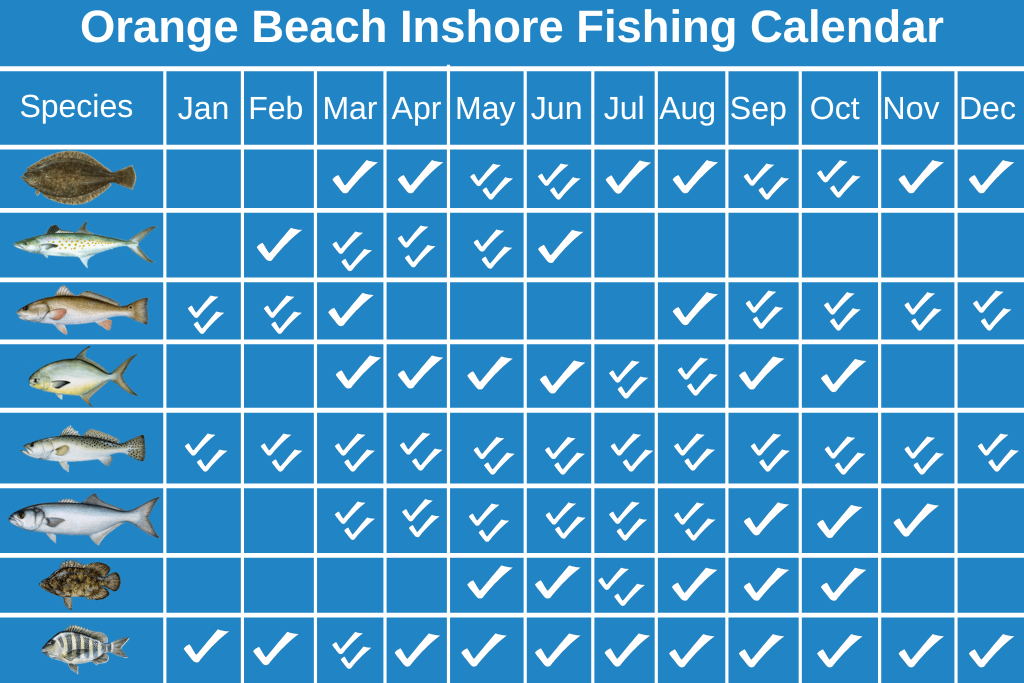
Where to go inshore fishing in Orange Beach?
You can start your trip by checking what’s biting in the calm, muddy flats inshore. Alternatively, you can head to Perdido Bay and its neighboring bayous and lagoons. However, you shouldn’t just lose yourself here. Pop over to Alabama Point and explore sandy back bays, deep holes, and rock jetties. There are various access points to Mobile Bay, too.
The Orange Beach inshore territory consists of shallow waters in bays, bayous, and coves. Alabama state waters extend up to nine miles out into the Gulf from the sandy white beaches. However, the local fishing community defines these waters as nearshore, instead of inshore. Depending on which species you’re after, you might be fishing the nearshore waters, too.
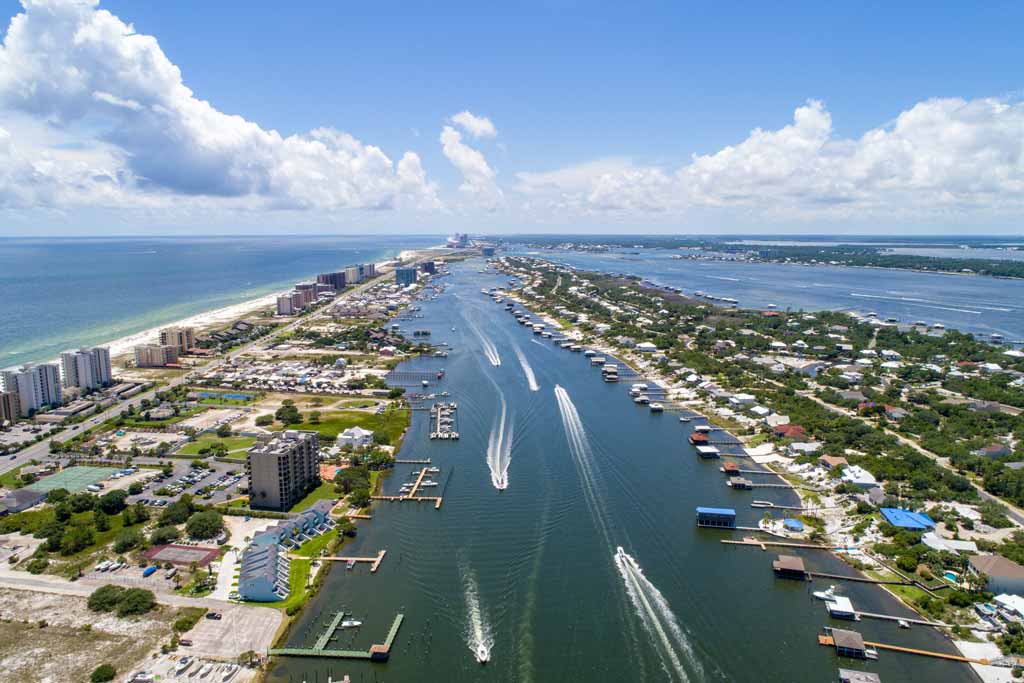
Here’s a quick list of places to explore on your Orange Beach inshore fishing adventure:
- Perdido Pass. You can target some of the most exciting inshore species right from the beach, a boat, or the boardwalk. In the Pass, the bays open into the Gulf, offering anglers the best of what’s in season.
- Bayou St. John (also known as Bay Ornocur and Ornocor Bay). Here, you can also fish right from shore or head out on a boat. The bayou is located 2.9 miles from Orange Beach. Don’t confuse this larger bayou with the one in New Orleans, LA, though!
- Gulf State Park Pier. Hurricane Sally damaged the pier, although it’s still accessible past the halfway point. This 1,500′ pier allows you to target Sheepshead, Spanish Mackerel, and a lot of other exciting species.
- Little Lagoon. This beautiful sheltered lagoon is arguably one of the most popular spots for inshore fishing towards Gulf Shores. You can get your fish on right from the shore or on a smaller boat or kayak.
How to go inshore fishing in Orange Beach?

Ask any local angler, and they’ll tell you that nothing gets you a Bull Red better than live minnow or finger mullet! Live bait and light tackle is the name of the game here. A lot of local anglers also use soft plastics and a variety of lures to get that bite.
Flounder gigging and flight fishing are also among the techniques you can use to target inshore fish in Orange Beach. You can take a look at our beginner’s guide to inshore fishing if you’re curious to learn more about how inshore fishing is done.
What you’ll be fishing for and how you do it depends on several factors, including the season and whether you’re fishing with a guide or solo. So, let’s talk about the various options you have for an Orange Beach inshore fishing trip.
Orange Beach Surf Fishing

While you may be familiar with the gorgeous sandy beaches overlooking the Gulf of Mexico, they aren’t just the perfect place to relax. You can also bring your fishing equipment and cast a line right from shore.
Various interesting species patrol the inshore waters, so you don’t always need a boat to enjoy some angling action. In fact, you can explore other spots throughout the city, too.
Gulfside aside, the Perdido Pass Bridge is another amazing spot for surf fishing. The roads, rocks, sands, and grass, along with the structure of the bridge, all attract various species of fish. Once you’re done there, head to the greenery around the bayous.
Orange Beach Pier Fishing
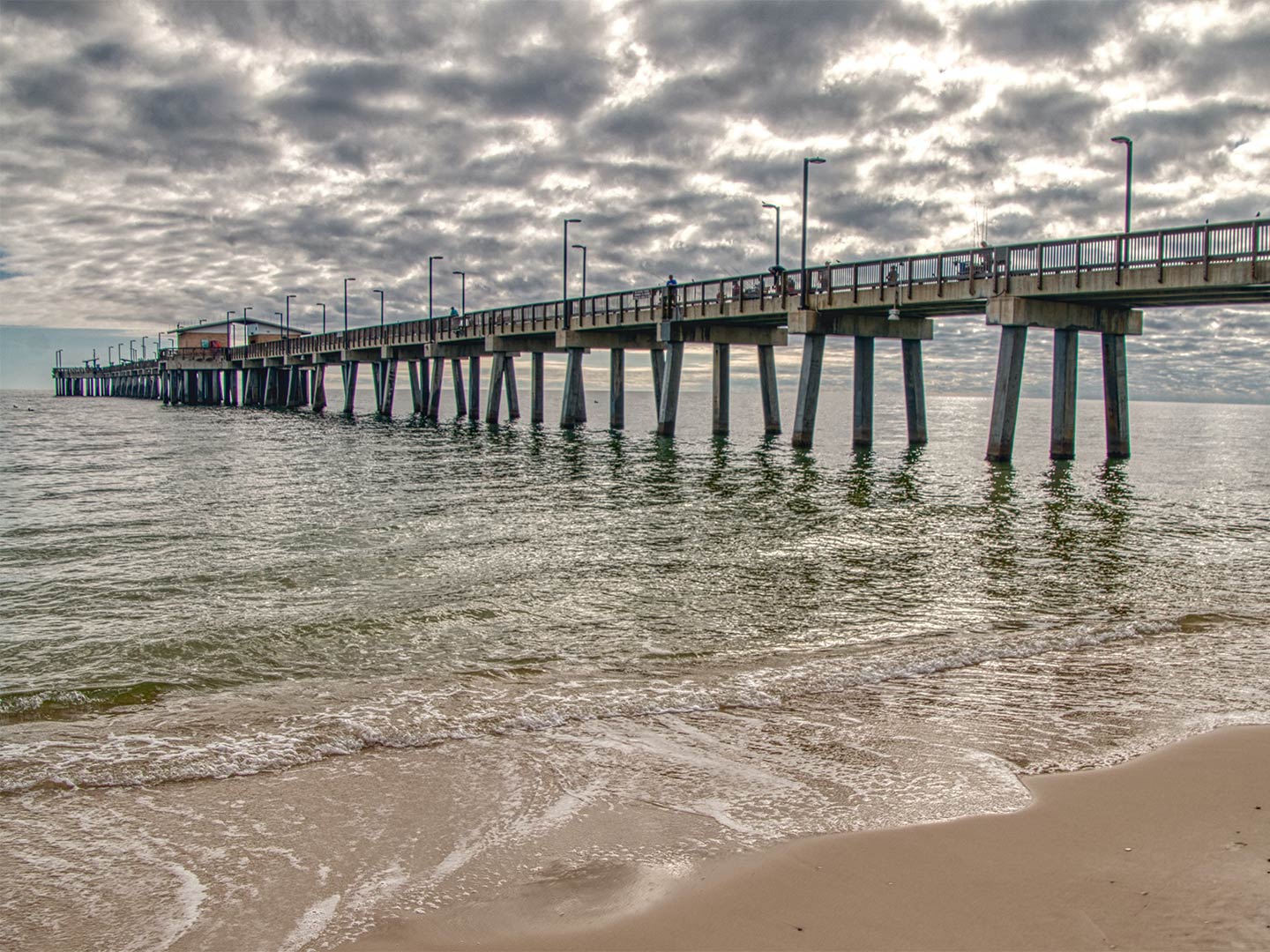
Pier fishing enthusiasts can enjoy their hobby in Orange Beach, too. It’s hard to not spot a fishing pier in the city, be it in the bayous or right on the Gulf.
So, what can you expect from Orange Beach Pier fishing? First of all, you’ll get the opportunity to set up camp for the day. Secondly, local piers offer great visibility to spot the fish. And last but not least, you can enjoy the benefits of the structure beneath that, as we all know, attract all sorts of fish.
Some locations, such as Waterfront Park, offer not only a fishing pier but also various picnic areas. You can bring your friends and family along, enjoy a relaxing day, and catch some fish.
Orange Beach Charter Fishing
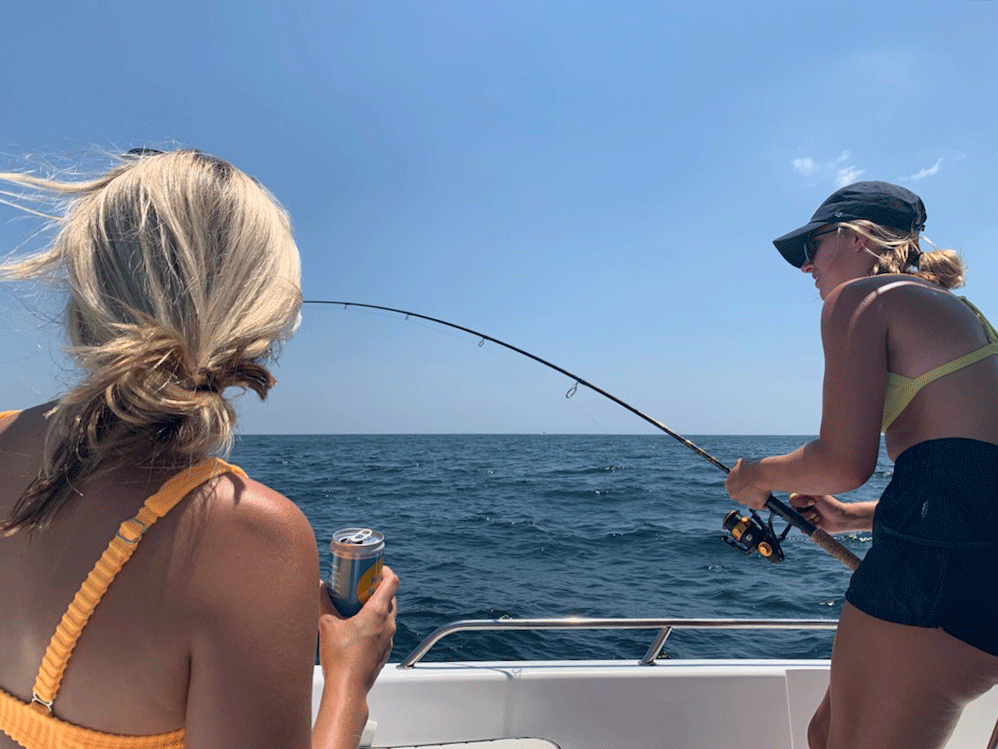
Not every angler knows which colors to use to get Pompano to gobble up flies. However, the majority of local guides do know this kind of stuff. They’ve worked the Orange Beach waters for generations, passing down a wealth of local knowledge.
Booking an Orange Beach inshore fishing charter allows you to perfect your techniques even if you’re already a pro angler. You can get to know the area a bit better and try your hand at various local methods. The same applies to beginner anglers. A local captain will work hard to show you the best the area has to offer and will do their best to make sure they don’t send you home empty-handed.
F.A.Qs
- Do I need a license to fish inshore in Orange Beach?
If you're fishing with a licensed charter or party boat, you won't need a license. However, all anglers aged 16 and over need to purchase a valid AL license when fishing from land or a pier. Feel free to learn more about Alabama fishing licenses in our handy guide.
- Are there any Orange Beach inshore fishing tournaments?
The Flora-Bama is the “Every Mans” fishing rodeo that takes place in June. Participants get the opportunity to target all kinds of fish, from smaller inshore species to bluewater monsters.
- Is inshore fishing kids-friendly?
The short answer is, of course, it is! Inshore fishing in Orange Beach is great for kids. Every year, parents bring their children down to Alabama's coast to help them catch their first saltwater fish. There are a few things you need to keep in mind, though. Make sure to book a trip with a family-friendly captain and check if there's a bathroom on board, as well as life vests of the suitable size for your kid.
- How far out will we go on an inshore trip?
The answer to that question depends on the specific trip you book. However, most captains will stay close to shore or up in the rivers and bays.
- How deep is the water?
The majority of Orange Beach inshore captains fish as shallow as 12 inches and as deep as 10 feet.
- Are there Sharks in Orange Beach?
Freshwater rivers are spawning grounds for Bull Sharks. As well as that, there are various smaller Sharks that hang out in the Perdido and Mobile Bays. But don't worry, these are great targets for anglers!
Inshore Fishing in Orange Beach – Full of Bulls And Gators!

We did our best to describe what inshore angling opportunities this small Alabama town has to offer. However, to fully understand the beauty of its bays, rivers, and bayous, you’ll need to come and see it yourself. Book a trip with a local guide and let them show you what inshore fishing in Orange Beach has to offer. Chances are, you might come back for more!
Have you ever been inshore fishing in Orange Beach? What did you catch? Let us know in the comments below. We’d love to hear your fish stories!
The post Inshore Fishing in Orange Beach: The Complete Guide appeared first on FishingBooker Blog.
https://ift.tt/Zv1nVbT
0 Comments
Enregistrer un commentaire